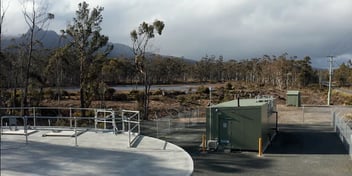Tasmanian boil alerts lifted as TasWater completes historic 24glasses program
Public health alerts have been removed from all TasWater connected water supplies, with the utility confident its customers can now enjoy a glass of water straight from the tap.
TasWater launched the 24glasses Regional Towns Water Supply Program in August 2016, with the aim of getting all health alerts lifted on 24 towns within 24 months. Over the past two years, it has built 17 water treatment plants, installed four water transfer pipelines, cleaned and upgraded water transfer mains, rehabilitated reticulation networks, and built water storage tanks.
Dr Dharma Dharmabalan, TasWater General Manager – System Performance and Major Projects, said the 24glasses project was an enormous task that required a collaborative team effort to think outside the box and deliver results for regional communities.
“Across the whole of Australia I can’t remember anybody doing this … Now you can say the state of Tasmania, which has a permanent population of half a million, has 60 water systems managed by TasWater, and all the water is drinkable straight from the tap,” he said.
“These communities have good road access, they have power supplies, they’ve got schools, hotels, pubs and, in some cases, the NBN. But water is life and they couldn’t drink their water.”
According to Dharmabalan, the biggest challenge was designing the system from start to finish. To begin, the team set out the key areas they needed to focus on: incorporating bold leadership; collaborative planning and partnership; knowledge and capacity; community engagement; budgets and finances; and regulation.
“The conventional thinking of project delivery had to change; we needed a new way of thinking. We wanted a catchment-to-tap approach – we didn’t want to do it piecemeal.”
Once they had formulated a strategy, TasWater packaged the project based on geography and engaged contractors including TRILITY, Stornoway, KBR, Zinfra and other local consultants to carry out the work.
“The goal was set and we said to the team, ‘You can plan to do it whichever way you want, but by 31 August 2018 all these customers should be able to drink water from their taps’. That was the objective of this exercise,” Dharmabalan said.
“Our aim wasn’t to complete the project – our aim was for the customers to drink the water. When they can drink the water the major project objective is achieved.”
As much of the work was done in small, isolated communities, Dharmabalan said TasWater needed to develop smart, fit-for-purpose designs. This included constructing treatment plants in local warehouses and transporting them to the site as a whole built in unit.
Working across so many towns was also challenge, as TasWater had to keep all of its customers informed. As an indication of the scope of the project, when TasWater was testing the final product to confirm it met Australian Drinking Water Guidelines, the team travelled 27,000km in five weeks and collected more than 4000 samples.
Dharmabalan said the project was a long-term investment to deliver safe drinking water to all Tasmanians.
“These assets are an intergenerational investment by TasWater for the next 30 to 50 years. This is an investment TasWater has made not only for the current generation but for generations to come.”
https://omny.fm/shows/australianwater/jennine-finlayson-on-safe-and-sustainable-drinking

